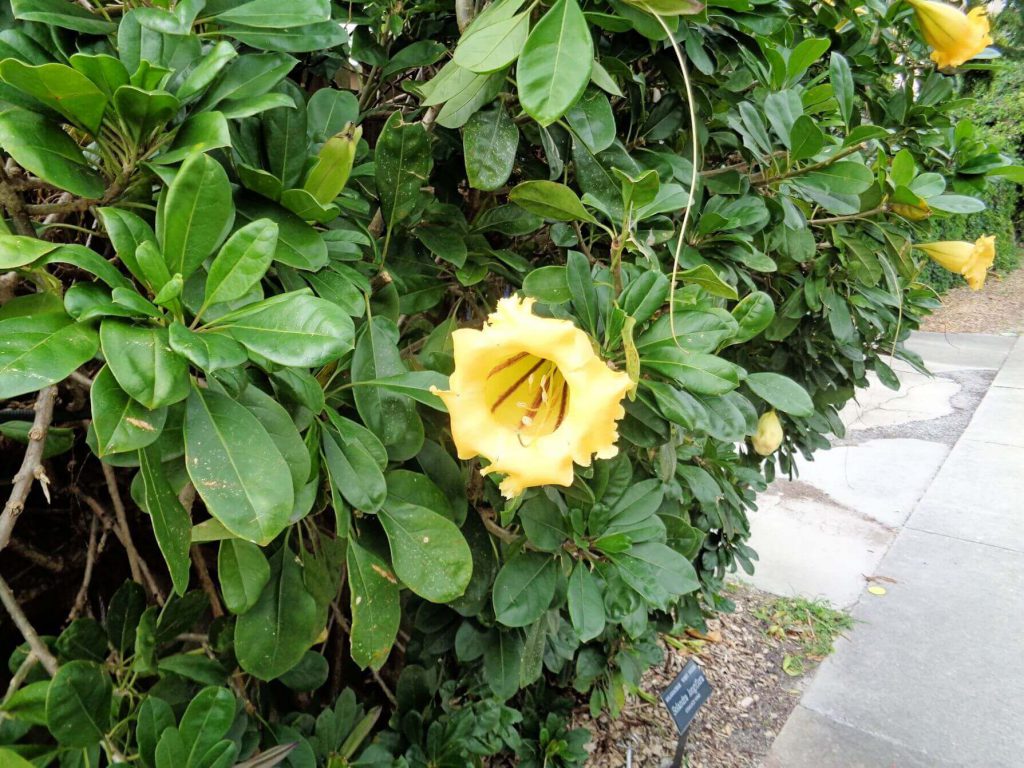By Ralph E. Mitchell
 At a recent visit to the Marie Selby Botanical Gardens© in Sarasota, a fenced entrance greeted me with a magnificent horticultural display of vines. One that I wrote about several weeks ago, was the garlic vine. Another one that was in bloom is known as the Chalice vine or Cup of Gold which specializes in winter blooms. While not commonly available at local garden centers, the chalice vine is a stunningly interesting and eye-catching plant – it is also considered toxic.
At a recent visit to the Marie Selby Botanical Gardens© in Sarasota, a fenced entrance greeted me with a magnificent horticultural display of vines. One that I wrote about several weeks ago, was the garlic vine. Another one that was in bloom is known as the Chalice vine or Cup of Gold which specializes in winter blooms. While not commonly available at local garden centers, the chalice vine is a stunningly interesting and eye-catching plant – it is also considered toxic.
The chalice vine can be found in nature from Mexico down through South America. A relative in the Nightshade Family which includes Datura, the chalice vine has thick, six-inch long evergreen leaves and seasonal gigantic nine to ten-inch long, five-inch wide flowers that do resemble a golden chalice or cup. The flowers are remarkable for their size and pleasant scent which releases at night. The fragrance reminds you of coconut, banana and/or even vanilla. But do not let this sweet smell let your guard down as the chalice vine is toxic! When pruning, wear gloves and keep cut plant parts away from your mouth and eyes. All parts of the chalice plant are toxic and ingestion can be deadly to children and pests, so consider this issue when deciding if the plant should be in your landscape in the first place.
The chalice vine is a very robust plant which can grow upwards of forty-feet long. Whatever structure you intend to grow it on must be extra heavy-duty to support the mass of this vine. It can be trimmed to keep it in bounds and perhaps shaped into a rugged hedge of sorts. The chalice vine likes a sun to part shade location and is salt tolerant once established.
There is one variation on the chalice vine which will make it ornamental throughout the year instead of just the winter blooms. One cultivar called ‘Variegata’ has white and green variegated leaves which initially come out with a purplish cast. This extra feature puts a new spin on the chalice vine and expands its beauty.
With its toxic reservations noted above, the chalice is a horticultural marvel! While it may be best visited at a botanical garden, also consider its careful placement in your own landscape. For more information on tropical vines suited for region, please call our Master Gardener volunteers on the Plant Lifeline on Mondays, Wednesdays and Fridays from 1 to 4 pm at 764-4340 for gardening help and insight into their role as an Extension volunteer. Just as a reminder, our new office is located at the North Charlotte Regional Park at 1120 O’Donnell Blvd, Port Charlotte FL 33953. The Plant Lifeline is now open at our new site. Our phone numbers and email addresses continue to remain the same. Don’t forget to visit our other County Plant Clinics in the area. Our Eastport Environmental Demonstration Garden is always open to the public outside the gate at 25550 Harbor View Road and will continue to be in operation. Master Gardener volunteers tend this garden on Tuesday mornings from 8 to 10 am and are available for questions. Ralph E. Mitchell is the Director/Horticulture Agent for the UF/IFAS Charlotte County Extension Service. He can be reached at 941-764-4344 or ralph.mitchell@charlottecountyfl.gov.
Resources:
Stallsmith, A. (2012) Cups of Gold: The Chalice Vine.
Florida Gardener.com. (2013) Solandra maxima ‘Variegata’ – http://www.floridagardener.com/pom/Golden%20Chalice%20Vine.htm
Southern Living (2019) CUP-OF-GOLD VINE, chalice vine.
Spengler, T. (2018) Chalice Vine Pruning: When To Prune Chalice Vines. Gardening Knowhow.
Landre, C.(2020) Unusual Vines of South Florida. South-Florida-Plant-Guide.com
Solandra. https://en.wikipedia.org/wiki/Solandra.
Park Brown S. & Knox, G. W. (2016) Flowering Vines for Florida. The University of Florida Extension Service, IFAS.
 1
1
